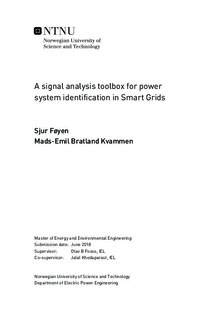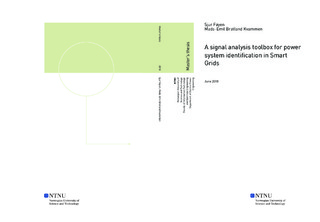| dc.description.abstract | This thesis delves into the two fields of signal analysis and small-signal stability of power
systems. Due to the extensive deployment of PMUs in today s Smart Grid, new possibilities
arise to assess the small-signal stability by measurement based techniques. The benefits of this approach are many, the most compelling being that the power system has become too complex to be accurately modelled with a component-based approach. A whole range of methods are available for the purpose of signal analysis in power systems, all with various assumptions, strengths and weaknesses. Insight into the analysis methods and the measurement data in itself is important for choosing the appropriate techniques for a given signal. The methods described in this thesis are: Prony s method, Robust Recursive Least Squares (RRLS) and the FFT based Welch s method. Prony s method is known as a ringdown (post-disturbance transient) analyzer, while the two latter are known as ambient analyzers.
To improve estimation robustness and accuracy, pre-filtering is implemented with the Empirical Mode Decomposition (EMD). This technique works as a non-linear and non-stationary band-pass filter, effectively extracting the desired frequency spectrum in the electro-mechanical range. This is validated using Welch s method, which reveals negligible change in the power spectral density of the investigated frequency range.
Both Prony s method and RRLS assume an underlying parametric model, and require specifying a model order. This issue is transformed into a benefit, extracting the consistent information from multiple analyses with varying model order. Clustering is used as post-processing intelligence to identify the dominant modes of the estimation. The third technique, Welch s method, is used for validation purposes.
The methods and data are contextualized; subsequently, the techniques are described with
relevant theory, and thoroughly tested for both simulated and real-world data. The estimation from ringdown data is compared to the estimation from ambient data, which in real-time scenario often is the only option for evaluation. The three analyzers contribute to mutual validation of the modal content, improving the credibility of the estimates. For simulated data, the measurement based estimation is also evaluated against eigenvalue inspection of the linearized power system model.
This thesis is based in part on a conference paper to be published at SPEEDAM 2018. This article describes theory of Prony s method, as well as the EMD and Clustering technique. Since then, the thesis has evolved in scope and depth. The results from detailed testing show that the investigated combination of methods performs well on real-world PMU-measurements. Prony s method identifies the modes of ringdown data and the RRLS method identifies the modal content in the ambient data. The damping ratio is in general slightly underestimated in the ambient data compared to ringdown data. However, both give a good indication of the modal content.
A comprehensive toolbox of the methods mentioned above has been indigenously created (in Python) as a part of thesis work; the toolbox utilizes weaknesses of some methods, e.g. the model order selection problem in Prony s method and RRLS, as input to other methods, such as the clustering technique. The result is an autonomous algorithm, taking care of each submethod s deficiency. | |

